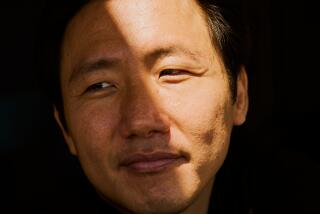Why ‘Spies in Disguise’ aims to teach kids violence isn’t the answer
In “Spies in Disguise,” super spy Lance Sterling gets turned into a pigeon and still has to figure out a way to save the world.
Luckily, Lance is not alone. In addition to a few actual pigeons that crash his mission, Lance has a literal genius on his side in Walter Beckett. Too bad Lance prefers to fly solo and has no interest in the alternative, non-lethal tech Walter has been developing.
Their dynamic and disparate approaches are at the core of the animated spy buddy comedy from Blue Sky Studios (“Ice Age,” “Rio,” “Ferdinand”) that hit theaters Christmas Day. And it’s Walter, voiced by Tom Holland, that gives the movie heart and subverts all the tropes of a traditional spy/hero.
“Walter is a really happy-go-lucky kid. He’s very positive and excited about using his brain to do good and make a difference,” said Holland in an email. “But what is most endearing about Walter is the way he is trying to change his agency’s way of thinking. So instead of responding with violence, he is pushing the idea that the best response is to try and spread happiness and positivity, to make everyone he can safe.”
Will Smith, Tom Holland star in the animated “Spies in Disguise,”in which a secret agent is transformed into a pigeon with the help of a nerdy scientist in this animated comedy.
More than just a “gadget guy,” Walter’s values and how they challenge Lance’s world view were key for directors Troy Quane and Nick Bruno who first and foremost saw “Spies in Disguise” as a spy movie.
“It was important for us to create a super spy in Lance Sterling that felt legit,” said Quane of the film’s capable, charming, funny and slightly arrogant secret agent. Voiced by Will Smith, Lance was envisioned as an animated counterpart that could hold his own against the likes of live-action greats such as James Bond, Jason Bourne and “Mission Impossible’s” Ethan Hunt.
But in recalling their favorite spy films, Bruno said they couldn’t help but notice all of the glorified violence that was a routine part of these movies.
Walter, therefore, was developed as an aspirational character whose commitment to finding other, better ways to solve problems is tied to his belief that using aggression and violence creates additional problems.
“Walter is not only a genius that came up with really cool gadgets, but those gadgets represent something,” said Quane. “They represent a point of view and a philosophy to challenge that ‘fight fire with fire’ idea that Lance came into the world with.”
These gadgets include the multi-pen, which looks like a harmless multi-colored pen but can shoot “serious string” to tie up bad guys, spray a lavender-scented truth serum and release an electrical pulse that temporarily turns a foe’s muscles into a useless rubbery mass.
There is also Kitty Glitter, which utilizes colorful glitter and images of kittens to diffuse situations by calming people down. There’s even a gadget called the inflatable hug.
Unfortunately, nobody at the agency takes Walter’s inventions seriously.
Quane and Bruno admit Walter’s gadgets were a fun challenge as they had to be funny without seeming stupid. “All of Walter’s gadgets are actually really smart” even if they initially seem ridiculous, they said.
Despite the creative embellishments, these gadgets are rooted in science in hopes of appealing to kids who are genuinely interested in the subject and to show them the kind of impact they can have by pursuing a scientific career.
Walter’s gadgets were also key to making sure the movie featured the action and spectacle expected in spy movies.
“When we really watched some of our favorite scenes [in spy movies] the spectacle is in the surprise. It doesn’t have to be violent,” said Bruno. “So with Walter’s gadgetry, we always wanted it to feel surprising and big and fun. That was the spectacle, and you didn’t feel like you missed big fiery explosions and firefights.”
Because of the nuance needed to balance all of Walter’s attributes — he is naive, socially awkward, good-natured, earnest, goofy and very, very smart — Quane and Bruno acknowledged that he was the hardest character to balance in the film. But his character was necessary for challenging everyone to think of better ways to do things.
Another idea Quane and Bruno wanted to dig into was how sometimes, the only thing separating heroes and villains is perspective.
“We’re both parents and I talk to my kids all the time and hear myself say, ‘Well, take a look at it from their point of view’ when they have altercations with kids at school or kids on their team. ‘How do you think they’re feeling about it?,’ ” said Quane. The idea “that our hero and our villain are just opposite sides of the same coin really became something we wanted to explore.”
“No bad guy is saying ‘I’m a bad guy. I’m going to do bad things,’ ” added Bruno. “Everyone’s trying to do what they feel is best for them or who they represent.”
Because everything the villain does at the end of the movie are things Lance Sterling was shown doing (and was celebrated for doing), Walter’s insistence on heroes doing better, and his commitment on seeing that through, is what sets him apart from everybody else.
Walter faces plenty of challenges in the film that test his conviction. Not the least of which is Lance, as well as everyone else in their agency, writing off Walter and his inventions as “weird.” But it’s Walter’s commitment to staying weird that cements his status as the aspirational hero of “Spies and Disguise.”
“It takes a lot of courage to be a Lance Sterling, to be out there in the middle of a firefight, to be in the middle of the action, facing down 100 bad guys,” said Quane. “But it takes an equal amount of courage to be someone like Walter who believes in something and stays true to that — is true to who they are and embraces the weird.”
The filmmakers hope that kids who watch Walter persevere in the movie will also see that it’s worth being your true, weird self.
“It’s not always gonna be easy and there’s gonna be people who doubt you, but there’s power in being true to who you are,” said Quane.
More to Read
Only good movies
Get the Indie Focus newsletter, Mark Olsen's weekly guide to the world of cinema.
You may occasionally receive promotional content from the Los Angeles Times.











